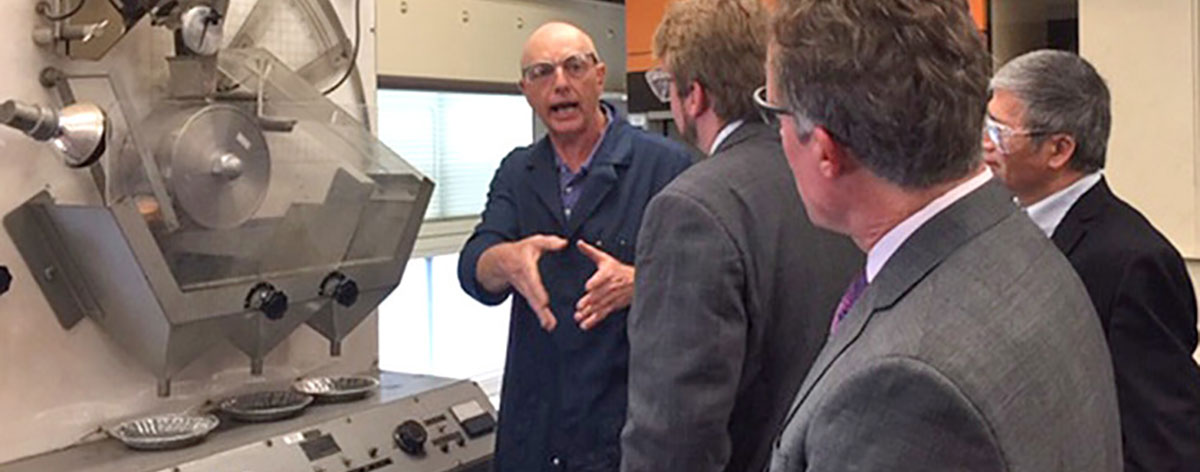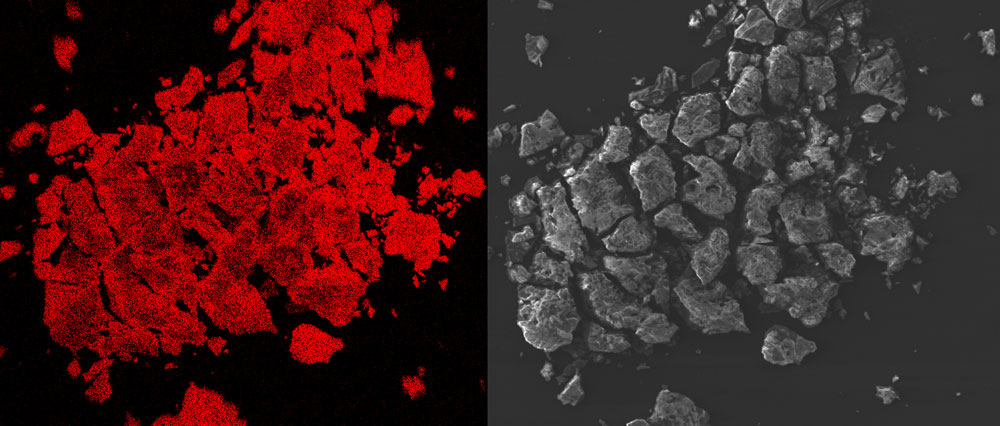The newly launched Center for Critical Minerals will leverage Penn State’s existing faculty, facilities, and research strengths in an effort to make the University the go-to resource for critical minerals research and technical support for industry. Initially launched by the College of Earth and Mineral Sciences and housed in the EMS Energy Institute, the center will expand to include scientists from across Penn State whose research expertise can be harnessed to address the issues posed by critical mineral exploration, characterization, separation, and production.
 Dr. Mark Klima explains lab research to Dr. Brian Anderson, Dr. Lee Kump, and Dr. Chunshan Song.
Dr. Mark Klima explains lab research to Dr. Brian Anderson, Dr. Lee Kump, and Dr. Chunshan Song.
Edward Steidle, former dean of Penn State’s College of Mineral Industries, the predecessor of the present College of Earth and Mineral Sciences, wrote these visionary words in 1952:
“American industry will be faced not only with a lack of raw materials at home, but also with the difficulty of obtaining supplies abroad.”
Those words still ring true today, and in response, Penn State has launched a new center, the Center for Critical Minerals.
Minerals are part of virtually every product manufactured in the modern global economy. New technologies from touch-screen displays to batteries to solar panels, including devices used in the medical, energy, and defense industries are increasingly reliant on specific critical minerals not widely used a few decades ago.
Many of these critical minerals are imported. They are classified as critical because they have high economic importance, high supply risk, and their absence would have significant consequences on the economic and national security of the United States.
The Center for Critical Minerals will leverage Penn State’s existing faculty, facilities, and research strengths in an effort to make the University the go-to resource for critical minerals research and technical support for industry.
Initially launched by the College of Earth and Mineral Sciences and housed in the EMS Energy Institute, the center will expand to include scientists from across Penn State whose research expertise can be harnessed to address the issues posed by critical mineral exploration, characterization, separation, and production.
“We have all the major disciplines and world-class faculty expertise required for this type of work within the college,” said Sarma Pisupati, professor of energy and mineral engineering and director of the center. “We have the skills at Penn State needed to advise industry on locating, mining, characterizing, processing, and utilizing critical minerals. We also have strengths in financial analysis.”
There are thirty-five minerals or mineral material groups that are currently considered critical. The list includes the rare earth element group, a set of seventeen metals necessary for devices that people use every day like rechargeable batteries, cellphones, and magnets. The U.S. imports nearly 100 percent of its needed rare earth elements, with China producing about 85 percent of the world supply.
“Penn State has a long tradition of meeting industry and government research needs in the minerals field,” said Pete Rozelle, a Penn State alumnus and a retired program manager for the U.S. Department of Energy (DOE), who is now serving as an adviser to the college on mineral resources. “From geologic exploration to mineral extraction technologies to techno-economic analyses, the University’s new Center for Critical Minerals offers a comprehensive set of capabilities to support the development of new U.S. sources for these mineral products.”
The new center will build on and expand Penn State’s current research examining cost-effective and environmentally friendly technologies to extract rare earth elements from clay layers associated with coal, coal waste products, and acid mine drainage.
“Extracting rare earth elements and other critical minerals from coal sequences and coal waste has the potential to bolster the state’s economy and provide new employment in mining regions,” said Lee Kump, John Leone Dean in the College of Earth and Mineral Sciences. “The opportunities for student engagement in the enterprise means that this initiative touches all aspects of the University’s mission of research, teaching, and outreach.”
Pisupati’s team and DOE researchers collaborated to successfully develop an economical way to extract rare earth elements from coal byproducts using an advanced ion exchange method.

EDS images isolating rare earth elements from coals wastes.
In another DOE-funded project, they partnered with Texas Mineral Resources Corp., Inventure Renewables Inc., and K-Technologies to investigate if the process would be feasible on an industrial scale. The overall goal is to find an economical way to extract rare earth elements and critical minerals, such as manganese and cobalt, from coal byproducts.
“Pennsylvania has the resources,” Pisupati said. “Pennsylvania coals and coal-associated products have the highest concentrations of these rare earth elements and critical minerals in the U.S. Penn State is well positioned to play a vital role in helping industrial partners here in the state.”
The center’s focus is to:
- Gain a fundamental understanding of the presence, chemical nature, and associations of critical mineral products in geologic formations, as well as secondary sources such as coal and other mining waste streams and metallurgical waste dumps, electronic waste and sludges from the treatment of acid mine drainage, and byproduct water from the oil and gas industry.
- Develop novel processes for extraction and separation/purification while advancing the fundamentals and developing technologies for sustainable recovery of critical materials.
- Develop financial models and project values utilizing realistic models for field-scale processes for mineral recovery and detailed databases for costs and price projections.
- Analyze alternate economic and policy scenarios and develop policy guidelines for implementation of field projects.
- Provide technical support for commercial project development activities associated with bridging value chain gaps.
Extracting rare earth elements and critical minerals benefits both the economy and the environment, the researchers said.
“Coal waste, underclays, metallurgical waste, acid mine drainage and its treatment sludges, and flowback and produced water in the Marcellus basin are additional sources of critical minerals, with low production costs, that could be tied to remediation and restoration efforts,” Pisupati said. “Extracting these materials is a win-win for Pennsylvania.”

